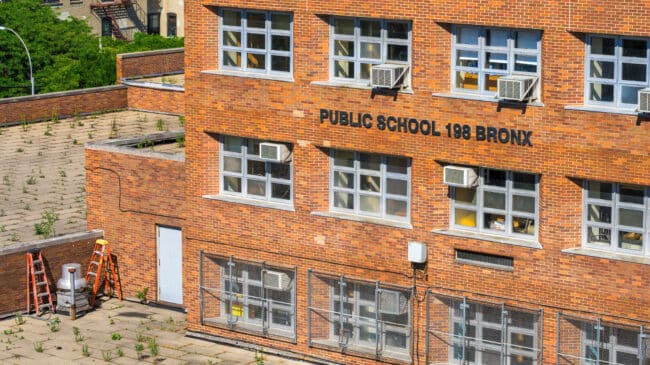School closures are becoming a fixture on school board meeting agendas, with places such as Boston, Philadelphia, Seattle, and many others grappling with under-enrolled public schools.
Public schools have lost nearly 1.2 million students since the start of the COVID-19 pandemic, and many school districts need to make the difficult and politically fraught decision to close neighborhood schools.
With declining birth rates, increased homeschooling, and more parents embracing private and charter schools, the National Center for Education Statistics (NCES) projects public schools will lose another 2.7 million students by 2031-32. Enrollment is expected to fall 15% from 2022-23 levels in California and New Mexico, with New York not far behind at nearly 14%, according to NCES.
With fewer students—and less funding—widespread public school closures, while challenging, are necessary and inevitable. However, the most recent federal data from 2021-22 shows that they were down by nearly one-third compared to pre-pandemic levels. There were fewer closures because districts plugged budget holes with the $190 billion in federal COVID-19 relief funding they got during the pandemic. But these federal dollars are expiring, and schools now feel the fiscal impact of losing students.
Without more recent school closure data, policymakers and other stakeholders are in the dark on a critical policy issue.
To shine a light on declining public school enrollment and school closures, Reason Foundation attempted to collect data from all 50 states via public information requests and other public sources. We obtained data from 15 states and excluded charter schools, alternative schools, and programmatic closures from the analysis to get the clearest picture possible of public schools. While our dataset has limitations—including rural states like Idaho and Vermont with relatively few schools to close— it provides much-needed insight into how things are playing out across states, including California, Colorado, Florida, Iowa, New York, Utah, and Virginia.
Our findings indicate that public school closures in these 15 states are on the upswing, with trends varying by state. In the three years before the COVID-19 pandemic (from 2017-18 to 2019-20), total combined school closures in the 15 states examined ranged from 84 to 99 a year. However, in 2020-21, they fell to 69 across the 15 states, and then again to only 65 in 2021-22, a 34% drop-off from 2019-20.
Importantly, total school closures started returning to pre-pandemic levels in 2022-23, with 82 total school closures across the 15 states and continued rising in 2023-24 with 98 closures—almost the same number as 2019-2020.
Chart 1: Public School Closures by School Year (15 States)
At the state level, there were notable increases in school closures in the last two school years. For instance, Colorado jumped from 11 closures in 2022-23 to 26 closures in 2023-24, and South Dakota went from no school closures in 2022-23 to 11 closures in 2023-24, with both states exceeding their pre-pandemic school closure levels by large margins in 2023-24.
Meanwhile, states like New York, Nebraska, and Iowa each returned to pre-pandemic closure levels by 2023-24 after sharp declines during the pandemic.
But California bucked these trends. Before the COVID-19 pandemic, the Golden State had 31 school closures in 2019-20, with closures then falling each year until 2023-24, when it had only seven closures—even fewer than Utah, which had eight.
Chart 2: School Closures by State
All told, total public school closures across the 15 states returned to pre-pandemic levels before federal relief funds expired in September 2025. However, given the magnitude of enrollment drops, many districts seem to be delaying the inevitable, just as experts feared.
This appears to be the case in California, where only a handful of public schools were closed in 2023-24 despite statewide enrollment plummeting by 5.1% between 2019-20 and 2022-23 (the latest federal enrollment data available). An analysis published by The 74 identified more than 1,400 schools in California where enrollment fell by at least 20% during the pandemic, including 125 schools in the Los Angeles Unified School District alone—that’s one in five of the district’s schools.
For many school districts, the recent years with significant federal relief funding was a missed opportunity that could’ve been spent to help smooth the transition for affected students. Now they’ll have to right-size without this budget cushion. But there’s also evidence that districts in some states—such as Colorado—took advantage of the additional dollars, with closures rising in each of the last three school years. This head start should be welcome news, though the trend is likely to continue: between 2019-20 and 2022-23, Colorado’s public schools lost over 42,000 students—about 4.6% of total enrollment.
Public school closures are difficult for communities, but declining enrollment means school boards must make tough decisions. While our 15-state dataset indicates that school closures have risen in the past two years, this is only the start of a difficult road ahead.
There’s much that state policymakers can do to help support this needed transition, but a good first step is requiring state education agencies to publish the most recent data on closed schools. Better yet, they could also publish annual data on under-enrolled public schools, so they know whether school boards are dealing with the problem or just kicking the can down the road. Transparency will be paramount in the coming years.



